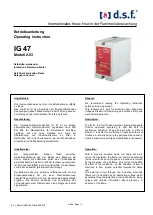
Introduction
1
1 Introduction
This manual provides installation, maintenance, and troubleshooting information for the
Daktronics VL-35X0 displays. For information regarding the safety, installation, operation,
or service of this system, please refer to the telephone numbers listed on the cover page
of this manual.
Daktronics identifies manuals by the ED or DD number located on the cover page of
each manual. For example, this manual would be referred to as
DD3934467
.
Daktronics builds displays for long life and little maintenance. However, from time to
time, certain display components need replacing. Refer to the
and Repair & Return Programs (p.25)
section if any component needs replacement or
repair.
Display Overview
Daktronics outdoor Vanguard
®
LED displays are designed and manufactured for
performance, reliability, ease of maintenance, and long life. The displays consist of an
array of LED pixels. The configuration of the LED pixels depends on the model of LED
displays.
A typical system consists of a central server computer and client computers running
Vanguard
®
software and of one or more displays. Daktronics Vanguard
®
software
package operates with Windows
®
XP, Windows
®
Vista
®
, Windows
®
7, Windows
®
8,
Windows
®
Server 2003, Windows
®
Server 2008, Windows
®
Server 2012 systems on an IBM
®
-
compatible computer.
The Vanguard
®
series VL-35X0 displays are matrix-based outdoor LED displays. The
Vanguard
®
model numbers are described as follows:
VL-35XX-RRxCCC-20-Z-SF
VL-35XX =
Outdoor Vanguard
®
display
RR
=
Number of rows high (16, 32, or 48)
CCC
=
Number of columns wide (48, 64, 80, 96, 112, 128,144, 160, 176, 192, 208, 224, 240, or
256)
20
=
Center-to-center pixel spacing
Z
=
Monochrome Amber (A), Red (R), or Full Color (RGB)
Network Concepts
Daktronics offers Ethernet and fiber-optic Ethernet network systems to interconnect and
control displays. One display network can comprise up to 240 displays. Each Daktronics
system is capable of performing multiple functions, including:
• Transferring messages.
• Programming messages to play on a display or group of displays in a network.
• Determining display statuses on a network.
The Daktronics VL-35X0 displays use one of the following communication methods. Refer
Signal Termination from Computer to Display (p.9)
section for more detailed
information.






































